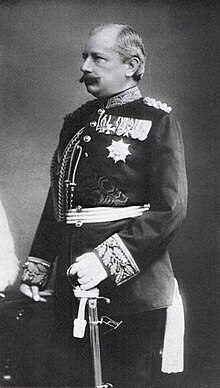Karl August of Saxe-Weimar-Eisenach (1844–1894)
Karl August Wilhelm Nicolaus Alexander Michael Bernhard Heinrich Friedrich Stephan of Saxe-Weimar-Eisenach (born July 31, 1844 in Weimar ; † November 20, 1894 in Roquebrune-Cap-Martin ) was Hereditary Grand Duke of Saxe-Weimar-Eisenach and Duke of Saxony.
Life
Karl August was the only son of Grand Duke Karl Alexander of Saxe-Weimar-Eisenach (1818–1901) from his marriage to Princess Sophie (1824–1897), daughter of King Wilhelm II of the Netherlands . After eight years of preliminary training by the private teacher Moritz Vermehren (1855–1863), he studied at the University of Jena , the University of Leipzig and the Ruprecht-Karls-University of Heidelberg . Since 1864 he was a corps bow bearer of the Corps Saxo-Borussia Heidelberg . Karl August served in the Grand Ducal Saxon Army and was second lieutenant in the Imperial Russian Hussar Regiment in Ingermanland . He wore the Grand Cross of the House Order of the White Falcon and the House Order of the Golden Lion . At the side of his father he took part in the imperial proclamation in Versailles on January 18, 1871.
Karl August married a second cousin in Friedrichshafen on August 26, 1873 : Princess Pauline (1852–1904) was a daughter of Prince Hermann von Sachsen-Weimar-Eisenach (1825–1901) and Princess Auguste (1826–1898), youngest daughter of King Wilhelm I of Württemberg . The wedding date had been postponed; originally it was planned to have the world premiere of the opera Aida outside of Italy in Weimar on the occasion of the wedding .
Karl August's mother was next in line to the Dutch throne after Princess Wilhelmina . This right passed on to their descendants. As the presumptive successor to the Dutch throne, Karl August learned to speak and write Dutch fluently.
In leisure hours, the Hereditary Grand Duke devoted himself to his collection of engravings and his coin collection. He was also interested in the grand ducal library and the newly built archive, where he often studied historical documents on the history of the house. His popularity and his uncomplicated approach to the residents of the Grand Duchy were praised. Minister of State Stichling judged him as one of those "who are necessarily more than they seem".
Because of a chronic illness, Karl August traveled to Menton for a spa stay , which was known to be beneficial for tuberculosis sufferers because of its climate . He died in Cap Martin six years before his father, which is why Karl August's eldest son succeeded him as Grand Duke of Saxe-Weimar-Eisenach. Karl August is buried in the Weimar Princely Crypt.
progeny
Karl August had two sons from his marriage:
- Wilhelm Ernst (1876–1923), Grand Duke of Saxe-Weimar-Eisenach
- ⚭ 1903 Princess Caroline Reuss zu Greiz (1884–1905)
- ⚭ 1910 Princess Feodora of Saxony-Meiningen (1890–1972)
- Bernhard Heinrich (1878–1900), Prince of Saxe-Weimar-Eisenach
literature
- Paul Friedrich Wilhelm von Bojanowski: Carl August, Hereditary Grand Duke of Saxony. A picture of life. H. Böhlau, Weimar 1895.
- Otto Devrient : For the moving-in ceremony of the newly weds Her Royal Highnesses Hereditary Grand Duke Karl August and Hereditary Grand Duchess Pauline of Saxe-Weimar-Eisenach. What we offer. Festival on September 8, 1873 in one act. Kühn, Weimar 1873.
- Angelika Pöthe: Carl Alexander. Patron in Weimar's ›Silver Era‹. Böhlau, Cologne 1998, ISBN 3-412-00498-7 .
- State manual for the Grand Duchy of Saxony-Weimar-Eisenach, p. 2. ( digitized version )
- Bernhard Post ; Dietrich Werner: Ruler at the turn of the century: Wilhelm Ernst von Sachsen-Weimar-Eisenach, 1876–1923. Glaux, Jena 2006, ISBN 978-3-931743-94-9 .
Individual evidence
- ↑ Bernhard Post, Dietrich Werner: Rulers in the turn of the ages. Wilhelm Ernst of Saxe-Weimar-Eisenach 1876–1923. Glaux, Jena 2006, p. 36.
- ↑ Theodor Toeche-Mittler: The imperial proclamation in Versailles on January 18, 1871 with a directory of the festival participants. ES Mittler & Sohn , Berlin 1896.
- ↑ H. Schnaebeli: photographs of the imperial proclamation in Versailles. Berlin 1871.
- ↑ Hans Busch: Verdi's Aida. St. Paul 1978, p. 301. ( digitized version )
- ↑ http://www.retrobibliothek.de/retrobib/seite.html?id=111904
- ↑ Bernhard Post, Dietrich Werner: Rulers in the turn of the ages. Wilhelm Ernst of Saxe-Weimar-Eisenach 1876–1923. Glaux, Jena 2006, p. 37.
- ↑ Bernhard Post, Dietrich Werner, op.cit., P. 38.
| personal data | |
|---|---|
| SURNAME | Saxe-Weimar-Eisenach, Karl August von |
| ALTERNATIVE NAMES | Saxe-Weimar-Eisenach, Karl August Wilhelm Nicolaus Alexander Michael Bernhard Heinrich Friedrich Stephan von (full name) |
| BRIEF DESCRIPTION | Hereditary Grand Duke of Saxe-Weimar-Eisenach and Duke of Saxony |
| DATE OF BIRTH | July 31, 1844 |
| PLACE OF BIRTH | Weimar |
| DATE OF DEATH | November 20, 1894 |
| Place of death | Roquebrune-Cap-Martin |


